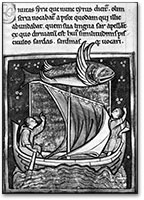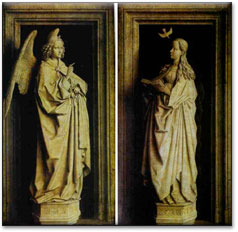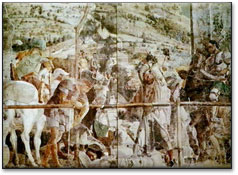| |
|

|
|
|
 |
|
|
Fig. 2.6
The Flying Fish of Tyre (ca. 1170). Ms. 81, the Pierpont Morgan Library,
New York.
|
Psychologically speaking, most pictures look
as if they were seen through a window - none of the objects seems to pop out
into the space of the room; the scenes they depict appear to be entirely behind
the surface of the painting. The evidence for this psychological observation
comes from the exception to this rule. In these rare exceptions, we see the
lengths to which an artist must go to coax the spectator into relinquishing
the assumption that the entire scene is behind a window. Take for instance
an anonymous illumination of the twelfth century (Figure 2.6). Because the
fish occludes part of the frame, we assume that it is flying in front of the
page. But to attribute this perceptual effect to the occlusion of a section
of the frame implies that, in the absence of this device, the scene would
be perceived to be entirely beyond the page. In other words, even in pre-perspectival
pictorial representations, we tend to perceive a picture frame as the frame
of a window through which we can look into the virtual space depicted by the
picture. One of the most brilliant applications of this method is in Jan van
Eyck's Annunciation (Figure 2.7). In this diptych,9 we
see the Angel Gabriel and Mary represented in a gray simulation of figures
sculpted in the round, standing on octagonal pedestals. Behind them, just
touching the far surface of the pedestals, we see a black mirror-like surface
in which the statues appear to be reflected, framed by dark moldings, part
of which are occluded by the angel's left wing and by Mary's cloak. The illusion
of protrusion is so strong that it is quite difficult to believe that this
is just a painting, rather than a reproduction of a pair of sculptures.10
It is possible to achieve the same effect
by propagation, that is, to have object A occlude the frame, and to suggest
(whether by occlusion or other means) that object B is in front of
object A: The result is that object B seems
to be in front of the picture plane. Such is one of the interesting perspective
effects used by Mantegna in his frescoes for the Ovetari Chapel (Figure 2.8).
Martyrdom of Saint James, the railing appears to be attached to the
front of the picture frame; that is why the torso of the soldier leaning over
it appears to emerge into the space of the chapel, above the floor onto which
Saint James's head will roll when it is severed.
 |
|
 |
 |
|
 |
| LEFT Fig.2.7.
Jan van Eyck, Annunciation (after 1432). Oil on wood. Thyssen-Bornemisza
Collection Fresco. Lugano-Castagnola, Switzerland. |
|
RIGHT Fig.2.8.Mantegna, Martyrdom
of Saint James (1451-5). Fresco. Ovetari Chapel, Eremitani Church, Padua. |
Returning now to our exposition of the elements of perspective,
there are three geometric properties of central projection that we must understand
in order to proceed with the analysis of the psychology of perspective.
